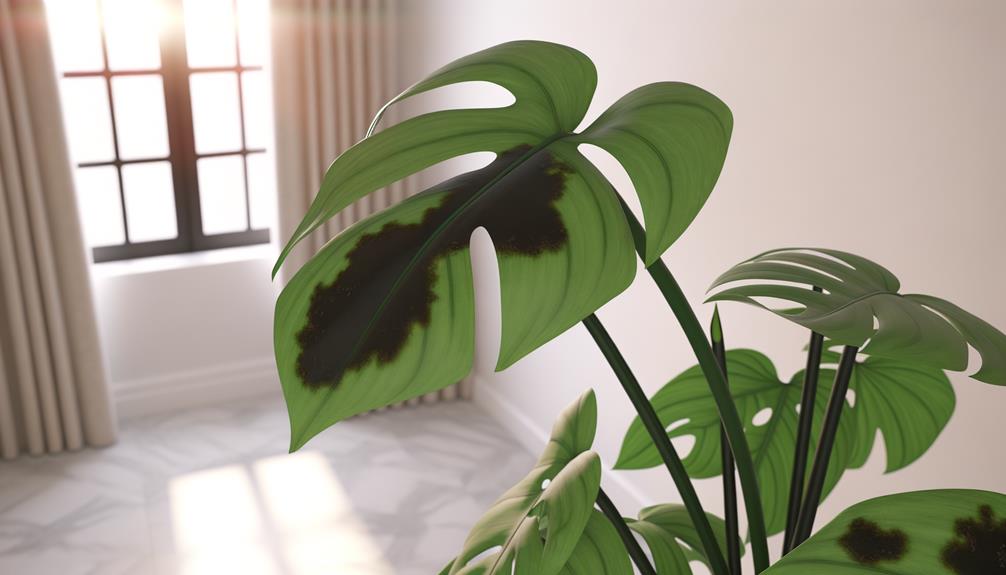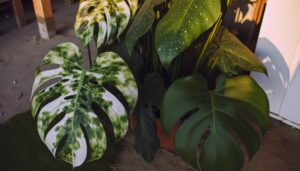What Should I Do if My Monstera Deliciosa Stems Are Turning Black?
If your Monstera Deliciosa stems are turning black, promptly assess your plant's environment and care routine. Overwatering often leads to root rot, so check soil moisture and guarantee efficient drainage.
Inspect roots for a soft texture or bad smell. Monitor for pests like spider mites and use insecticidal soap if needed.
Evaluate the soil mix and potting conditions to make sure they're well-draining and aerated. Adjust watering frequency and use distilled or rainwater to prevent mineral buildup.
Maintaining moderate humidity and good air circulation can also help. Master these steps to give your Monstera the best chance of recovery.

Key Takeaways
- Inspect for root rot by checking for soft, discolored roots and a foul smell.
- Evaluate watering habits and ensure efficient drainage to prevent root rot.
- Check for signs of fungal infection like mold or mildew and treat accordingly.
- Examine the plant for pests such as spider mites or aphids and use appropriate treatments.
- Ensure proper environmental conditions, including humidity and air circulation, to promote plant health.
Identify the Problem
When you notice the stems of your Monstera Deliciosa turning black, it's important to diagnose the underlying cause accurately to prevent further damage. Start by inspecting the plant for signs of fungal infection, such as mold or mildew on the soil surface or leaves.
Use a magnifying glass to check for pests like spider mites or aphids, which can cause disease and weaken the plant. Evaluate the plant's environment—consider factors like humidity levels, temperature fluctuations, and air circulation.
Additionally, assess any recent changes in care routines, like repotting or fertilization, that might've stressed the plant. By meticulously examining these variables, you can pinpoint the root cause of the blackening stems and take corrective action promptly.
Assess Watering Habits
You should examine your watering frequency, as overwatering can lead to root rot, causing stems to turn black.
Regularly check soil moisture levels using a hygrometer to avoid waterlogged conditions.
Confirm the drainage system is efficient by using well-draining soil and pots with adequate drainage holes.
Adjust Watering Frequency
To prevent Monstera deliciosa stems from turning black, it's crucial to carefully assess and adjust your watering frequency based on the plant's specific needs and environmental conditions. Start by understanding that overwatering can lead to root rot, causing stems to darken. Research indicates that Monstera deliciosa thrives with a balanced hydration schedule.
Monitor ambient humidity levels and indoor temperatures, as these factors greatly influence soil moisture retention. Implement a watering regimen tailored to seasonal changes; typically, water less in winter when growth slows. It's advisable to use room-temperature, dechlorinated water to avoid shocking the roots.
Check Soil Moisture
In order to accurately assess your watering habits, regularly check the soil moisture level by inserting a moisture meter or your finger about two inches into the soil. Make sure it remains consistently damp but not waterlogged. Monitoring soil moisture helps prevent overwatering, a common cause of black stems.
Moisture Meter Readings: Aim for a reading of 4-7 on a typical moisture meter for Monstera.
Finger Test: Soil should feel slightly damp but not saturated.
Observation Frequency: Check moisture levels every 4-5 days.
Water Source: Use distilled or rainwater to avoid mineral buildup.
Soil Composition: Confirm the soil mix contains adequate aeration components, like perlite or bark.
Accurate monitoring is essential to maintaining healthy Monstera Deliciosa stems.
Improve Drainage System
Improving your plant's drainage system is crucial for preventing water accumulation that can result in blackened Monstera Deliciosa stems. Start by choosing a well-draining potting mix, such as one with perlite or orchid bark, which improves aeration.
Guarantee your pot has multiple drainage holes to facilitate water outflow. Regularly evaluate your watering habits; excessively saturated soil limits oxygen, promoting root rot. Water your Monstera only when the top 2-3 inches of soil are dry. Employ a moisture meter for accurate readings.
Raise the pot using a plant stand to prevent water stagnation at the base. Additionally, consider repotting annually to refresh the soil and inspect for compacted roots. These steps will reduce excess moisture, ensuring healthier stems.
Check for Root Rot
When you notice blackening stems, it's essential to inspect the roots for signs of rot, such as a soft texture and a bad smell. Root rot is commonly caused by overwatering or poorly drained soil, leading to anaerobic conditions that foster pathogenic fungi.
Soft texture: Healthy roots should be solid. If they're soft, rot has likely set in.
Unpleasant odor: A strong, unpleasant fragrance often accompanies root rot.
Discolored roots: Healthy roots are white or light tan. Dark brown or black roots indicate rot.
Wilting leaves: Even with sufficient watering, wilting can indicate root complications.
Growth stagnation: If your Monstera Deliciosa isn't growing, root rot might be the issue.
Addressing root rot promptly can save your plant from further harm.
Inspect for Pests
Examine your Monstera Deliciosa meticulously for common pests, such as spider mites, mealybugs, and scale insects, which can cause blackened stems by feeding on the plant's sap and transmitting diseases. Use a magnifying glass to inspect the undersides of leaves and along stems.
Spider mites appear as tiny, moving dots, sometimes leaving fine webs. Mealybugs are small, white, cotton-like masses often found in leaf axils. Scale insects resemble small, immobile bumps that adhere to stems and leaves.
If you identify any pests, treat your Monstera with insecticidal soap or neem oil, ensuring thorough coverage. Regularly monitor your plant, as pest infestations can recur, necessitating repeated treatments to fully eradicate the problem and restore your plant's health.
Evaluate Potting Conditions
After confirming your Monstera Deliciosa is pest-free, it's essential to evaluate the potting conditions. Improper soil mix, drainage, or container size can lead to blackened stems.
Start by examining the potting medium. Monstera Deliciosa thrives in a well-draining, aerated soil mix, ideally containing components like perlite and peat moss. Check the drainage holes to make sure they're unobstructed, preventing waterlogged conditions that promote root rot.
Also, consider the container size; an overly large pot can retain excess moisture.
Key factors to evaluate:
- Soil Composition: Ensure it's well-draining and aerated.
- Drainage Holes: Confirm they're clear and functional.
- Pot Size: Avoid excessively large containers.
- Watering Frequency: Adjust to the soil's drying rate.
- Humidity Levels: Maintain moderate humidity.
Adjust Care Routine
To prevent the stems of your Monstera Deliciosa from turning black, you should fine-tune your care routine by closely monitoring watering practices and adjusting environmental conditions.
Make sure the soil remains moist but not waterlogged; overwatering can lead to root rot, which manifests as blackened stems. Utilize a well-draining potting mix and avoid letting the plant sit in standing water.
Additionally, maintain ideal humidity levels between 60-80% and guarantee adequate air circulation to prevent fungal growth. Monitor ambient temperatures, keeping them within the range of 65-85°F.
Conclusion
You've identified the problem and assessed watering habits.
Checked for root rot and inspected for pests.
Evaluated potting conditions.
Now, it's time to adjust your care routine.
Are you ready to see your Monstera deliciosa thrive again?
By ensuring proper watering, addressing root health, and optimizing environmental factors, you're taking critical steps towards revitalizing your plant.
Remember, consistent care and vigilance will transform those black stems into healthy, vibrant growth.






